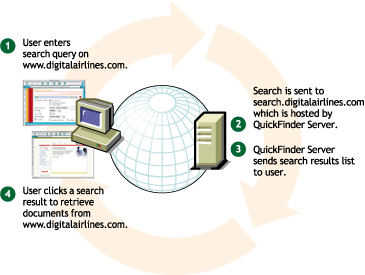3.3 Designing Your Search Solution
QuickFinder Server is a search service solution designed for adding powerful search capabilities to individual Web sites. It is not intended to index the entire Internet. However, because many Web sites are comprised of multiple Web and file servers located across an enterprise, QuickFinder is designed to be able to index hundreds, even thousands, of Web sites and file servers as part of a single search solution.
This section includes the following information:
3.3.1 Components of a Virtual Search Server
Providing search services involves creating one or more virtual search servers.
A virtual search server is a fully functioning, self-contained search service created for a particular audience, such as a department, organization, or a specific group of customers.
A virtual search server typically contains its own indexes, log files, administration interface, search and print templates, scheduled events, virtual search server name, and optional aliases. When you create a new virtual search server, a new directory is created in the /var/lib/qfsearch/Sites subdirectory. This subdirectory contains supporting configuration files and subfolders for storing indexes.
When you create a new virtual search server, you create an independent search service, meaning that it is self-contained and doesn’t depend on, or interact with, other virtual search servers.
NOTE:Users cannot search more than one virtual search server at a time. However, a virtual search server can contain indexes created from content on multiple Web sites or file servers.
Taking the time to plan your search service strategy can save you time and money and improve the quality of your service.
In addition to an administrative interface, each virtual search server that you create typically contains one or more of the following components:
-
Indexes: Files that hold key words and associated URLs of Web sites or file server content that have been indexed, or crawled.
-
Scheduled Events: Index management, such as updating or regenerating, can be automated to occur at specific intervals by using the Scheduling feature.
-
Search and Print Results Templates: Templates that are populated with the results of a search and then displayed to the user. Depending on which templates are used, the level of detail displayed in search and print results varies.
-
Themes: A collection of templates that share a common look and feel and that work together to provide a rich end-user search experience. A theme includes your search page, search and print results pages, and response and error message pages.
-
Configuration Settings: Includes information such as stop words, keyword-redirects, synonyms, and security settings.
-
Query reports: Summary reports, in HTML format, of the query log data.
3.3.2 Deciding If You Need More Than One Virtual Search Server
To determine if you need more than one virtual search server, answer the following questions:
-
Do you want to host search services for multiple, independent organizations or Web sites?
-
Do you want to consolidate multiple QuickFinder servers onto a single machine?
-
Do you need to prevent users from being able to search across multiple indexes at the same time?
If you answered yes to any of these, you probably need to create more than one virtual search server. Otherwise, a single virtual search server might suffice. For more information about virtual search servers, see Section 8.0, Creating and Managing Virtual Search Servers.
3.3.3 Becoming a Search Service Host
Companies who want customers to find information about their products typically outsource this function to search service companies. With QuickFinder Server, you can offer professional search services for other companies. Using a single installation of QuickFinder, you can host many virtual search servers simultaneously, which means that you could use the same server to host search services for several client or customer Web sites.
The following diagram shows how a search query on the Web site www.digitalairlines.com is sent to a QuickFinder server on the domain search.digitalairlines.com.
Figure 3-1 How a Search Query is Sent to the QuickFinder Server and Processed
